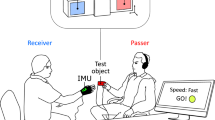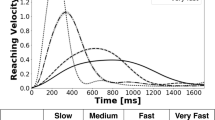Abstract
Grip force has been studied widely in a variety of interaction and movement tasks, however, not much is known about the timing of the grip force control in preparation for interaction with objects. For example, it is unknown whether and how the temporal preparation for a collision is related to (the prediction of) the impact load. To study this question, we examined the anticipative timing of the grip force in preparation for impact loads. We designed a collision task with different types of load forces in a controlled virtual environment. Participants interacted with a robotic device (KINARM, BKIN Technologies, Kingston) whose handles were equipped with force sensors which the participants held in precision grip. Representations of the hand and objects were visually projected on a virtual reality display and forces were applied onto the participant’s hand to simulate a collision with the virtual objects. The collisions were alternating between the two hands to allow transfer and learning between the hands. The results show that there is immediate transfer of object information between the two hands, since the grip force levels are (almost) fully adjusted after one collision with the opposite hand. The results also show that the grip force levels are nicely adjusted based on the mass and stiffness of the object. Surprisingly, the temporal onset of the grip force build up did not depend on the impact load, so that participants avoid slippage by adjusting the other grip force characteristics (e.g., grip force level and rate of change), therefore considering these self-imposed timing constraints. With the use of catch trials, for which no impact occurred, we further analyzed the temporal profile of the grip force. The catch trial data showed that the timing of the grip force peak is also independent of the impact load and its timing, which suggests a time-locked planning of the complete grip force profile.




Similar content being viewed by others
References
Bares M, Lungu OV, Liu T, Waechter T, Gomez CM, Ashe J (2011) The neural substrate of predictive motor timing in spinocerebellar ataxia. Cerebellum 10:233–244
Bleyenheuft Y, Lefevre P, Thonnard J-L (2009) Predictive mechanisms control grip force after impact in self-triggered perturbations. J Mot Behav 41:411–417
Bootsma RJ, van Wieringen PC (1990) Timing an attacking forehand drive in table tennis. J Exp Psychol Hum Percept Perform 16:21
Brenner E, Smeets JB (2009) Sources of variability in interceptive movements. Exp Brain Res 195:117–133
Brenner E, Smeets JB (2011) Continuous visual control of interception. Hum Mov Sci 30:475–494
Brenner E, Smeets JB (2015) How people achieve their amazing temporal precision in interception. J Vis 15:8
Brenner E, Smeets JB, de Lussanet MH (1998) Hitting moving targets continuous control of the acceleration of the hand on the basis of the target’s velocity. Exp Brain Res 122:467–474
Delevoye-Turrell Y, Giersch A, Danion J-M (2003) Abnormal sequencing of motor actions in patients with schizophrenia: evidence from grip force adjustments during object manipulation. Am J Psychiatry 160:134–141
Flanagan JR, Tresilian JR (1994) Grip-load force coupling: a general control strategy for transporting objects. J Exp Psychol Hum Percept Perform 20:944
Flanagan JR, Wing AM (1993) Modulation of grip force with load force during point-to-point arm movements. Exp Brain Res 95:131–143
Flanagan JR, Wing AM (1997) The role of internal models in motion planning and control: evidence from grip force adjustments during movements of hand-held loads. J Neurosci 17:1519–1528
Gibson JJ (2014) The ecological approach to visual perception, classic edn. Psychology Press, London
Johansson R, Westling G (1988) Programmed and triggered actions to rapid load changes during precision grip. Exp Brain Res 71:72–86
Kietzman ML, Sutton S (1968) The interpretation of two-pulse measures of temporal resolution in vision. Vis Res 8:287–302
Lefèvre P, Bottemanne I, Roucoux A (1992) Experimental study and modeling of vestibulo-ocular reflex modulation during large shifts of gaze in humans. Exp Brain Res 91:496–508
Lucas M, Chaves F, Teixeira S, Carvalho D, Peressutti C, Bittencourt J, Velasques B, Menéndez-González M, Cagy M, Piedade R (2013) Time perception impairs sensory-motor integration in Parkinson’s disease. Int Arch Med 6:39
McIntyre J, Zago M, Berthoz A, Lacquaniti F (2001) Does the brain model Newton’s laws? Nat Neurosci 4(7):693
Mcleod P, Jenkins S (1991) Timing accuracy and decision time in high-speed ball games. Int J Sport Psychol 22:279–295
Nowak DA, Hermsdörfer J (2006) Predictive and reactive control of grasping forces: on the role of the basal ganglia and sensory feedback. Exp Brain Res 173:650–660
Nowak DA, Glasauer S, Hermsdörfer J (2004) How predictive is grip force control in the complete absence of somatosensory feedback? Brain 127:182–192
Regan D (1992) Visual judgements and misjudgements in cricket, and the art of flight. Perception 21:91–115
Ruddy KL, Carson RG (2013) Neural pathways mediating cross education of motor function. Front Hum Neurosci 7:397
Schubotz RI, Friederici AD, Von Cramon DY (2000) Time perception and motor timing: a common cortical and subcortical basis revealed by fMRI. Neuroimage 11:1–12
Serrien D, Kaluzny P, Wicki U, Wiesendanger M (1999) Grip force adjustments induced by predictable load perturbations during a manipulative task. Exp Brain Res 124:100–106
Sober SJ, Sponberg S, Nemenman I, Ting LH (2018) Millisecond spike timing codes for motor control. Trends Neurosci 41:644–648
Srivastava KH, Holmes CM, Vellema M, Pack AR, Elemans CP, Nemenman I, Sober SJ (2017) Motor control by precisely timed spike patterns. Proc Natl Acad Sci 114:1171–1176
Thompson P (1982) Perceived rate of movement depends on contrast. Vis Res 22:377–380
Turrell YN, Li F-X, Wing A (1999) Grip force dynamics in the approach to a collision. Exp Brain Res 128:86–91
Valera EM, Spencer RM, Zeffiro TA, Makris N, Spencer TJ, Faraone SV, Biederman J, Seidman LJ (2010) Neural substrates of impaired sensorimotor timing in adult attention-deficit/hyperactivity disorder. Biol Psychiat 68:359–367
White O, Thonnard J-L, Wing A, Bracewell R, Diedrichsen J, Lefèvre P (2011) Grip force regulates hand impedance to optimize object stability in high impact loads. Neuroscience 189:269–276
Acknowledgements
The authors would like to thank Laurane Guiot, for her help to collect the data and design the protocol, as well as the participants of this study for their kind participation in this time- and energy-consuming experiment. This research was supported by a Rubicon Grant (446-17-003) from the Netherlands Organization of Scientific Research (NWO) (to IAK), by a Grant from the European Space Agency, ARC (Actions de Recherche Concertée), Prodex, and IAP VII/19 DYSCO (BELSPO, Belgian Federal Government).
Author information
Authors and Affiliations
Corresponding author
Ethics declarations
Conflict of interest
The authors declare that they have no conflict of interest.
Additional information
Publisher's Note
Springer Nature remains neutral with regard to jurisdictional claims in published maps and institutional affiliations.
Rights and permissions
About this article
Cite this article
Kuling, I.A., Salmen, F. & Lefèvre, P. Grip force preparation for collisions. Exp Brain Res 237, 2585–2594 (2019). https://doi.org/10.1007/s00221-019-05606-y
Received:
Accepted:
Published:
Issue Date:
DOI: https://doi.org/10.1007/s00221-019-05606-y




